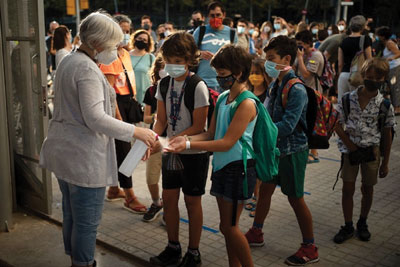
By Michael Birnbaum, Ruth Eglash and James McAuley
(Eglash reported from Jerusalem and McAuley reported from Paris)
 Israel, Spain and France all fought the novel coronavirus into abatement in the first months of the pandemic with tough measures that won international praise. But the three countries now share a painful distinction: Their infection rates have shot past that of the United States, even though Americans never got the virus under control.
Israel, Spain and France all fought the novel coronavirus into abatement in the first months of the pandemic with tough measures that won international praise. But the three countries now share a painful distinction: Their infection rates have shot past that of the United States, even though Americans never got the virus under control.
The experience of these three nations demonstrates the difficulty of keeping the virus at bay, experts and officials say, and how re-opening too quickly and other missteps can undermine successful national policies. For countries with more chaotic approaches, such as the United States, the challenge may be even greater.
“We are going into a worsening situation,” Hans Kluge, the World Health Organization’s top official in Europe, told reporters Thursday. He said the rising numbers on the continent should serve as “a wake-up call for all of us” to be more vigilant about the transmission of the disease.
Israel, meanwhile, entered a new three-week lock-down Friday, a particularly bitter blow because it coincides with the beginning of the Jewish High Holy Days.
Taking, into account population, a handful of countries have higher rates of coronavirus diagnoses than the United States does. But Israel, Spain and France — all similarly positioned to the United States, in that they are democracies with advanced medical systems and deep pockets — stand out for having made dramatic progress against the health menace before seeing gains reversed.
Israel used an aggressive trace-and-quarantine program to keep its death rates lower than many of its peers. Spain, which was so overwhelmed by death that it had to turn a Madrid ice rink into a morgue, forced citizens to stay inside their homes for six weeks with few exceptions. French residents needed signed attestations that they were doing necessary errands during the hour they were allowed out of their homes every day.
By early June, after months of lockdown, each of these countries had managed to push cases down to about 1 per 100,000 people every day. U.S. cases had been rising and stood at 6.4 per 100,000 residents.
Europe thinks it is past the peak of the first wave of the coronavirus
“We were hit hard, extremely hard, but we resisted. We flattened the curve, we contained the spread of the virus, and we did it together,” Spanish Prime Minister Pedro Sánchez said in a national address on June 20, hours before his government lifted a state of emergency.
“We will be vigilant,” he said. “But we should also be proud of what we have achieved.”
The same day Sánchez was basking in Spain’s success, a very different message was coming from the president of the United States. American coronavirus cases were 11 times those of Spain’s, adjusted for population, and President Trump was holding an indoor campaign rally in Tulsa, over the objections of public health officials. He called tests “a double-edged sword,” because conducting them leads to finding more cases.
U.S. cases peaked a month later and have remained stubbornly high ever since.
But cases were also about to resume their rise in Spain and France and had already begun increasing in Israel. A moment of respite — when lockdown measures were eased without triggering a visible rise in cases — was coming to an end.
Why Israel is seeing a coronavirus spike after initially crushing the outbreak
Israel now has one of the worst infection rates in the world given its population: Over the past week, it has reported an average of 47 cases per day per 100,000 residents. Spain, which has averaged 22 cases per day per 100,000 people, and France, which has averaged 13, have also been setting daily records.
The United States registered an average over the past week of 12 cases per day per 100,000 people.
The comparisons are imperfect, as testing availability differs from country to country, and some may be undermeasuring. The death rate in the United States remains the worst of the four countries: Adjusted for population, its deaths are nearly 1.5 times Israel’s, double that of Spain and five times that of France.
“The USA is still tackling their first major peak and will see further down the line some very similar challenges that a number of European countries are facing now,” said Catherine Smallwood, a senior emergency officer at the WHO Health Emergencies Program.
She noted that because public health systems are better prepared than in the spring, the resurgence does not necessarily foretell the same level of human suffering as earlier this year, nor does it necessarily require countrywide, blanket lockdowns to get it under control.
Coronavirus cases in some European countries are rising again, but with fewer deaths. For now.
Some Spanish experts say that the rigidity of their lockdown may have led to a rush to reopen.
“The lockdown in Spain was fantastic. It was probably the country that did the best. It was very serious,” said Rafael Cantón, the head of microbiology at the Ramón y Cajal University Hospital in Madrid. “But probably because of these months of very strict lockdown, when we opened, it was very quick, unfortunately. There was a background of virus that was in the population.”
His hospital was slammed at the outset of the pandemic. By the end of March, 1,000 coronavirus patients had crowded into its wards, 100 over its ordinary capacity.
Four months later, Cantón said, the hospital felt like a different world — an almost normal one.
“In parts of July, we didn’t have any patients here because of coronavirus,” he said.
But when he saw the first handful of new coronavirus patients come in again at the beginning of August, he said, he had a sinking feeling.
“I said, ‘Okay, that’s not a good situation,’” Cantón said. Now there are 200 coronavirus patients again in the hospital, he said.
Most of Spain’s new cases are mild and concentrated among younger, more resilient people, experts say, although hospitalization numbers are shooting up, as are deaths.
Public health officials blame the increase in cases on a virus-friendly cocktail. Vacation season spread the virus across the country. Families reunited, sometimes breaking size limits on gatherings. Teenagers embraced late-night drinking sessions, also ignoring rules on public gatherings. Pandemic policymaking was largely delegated to regional governments, which led to sharply divergent rules and strategies. And testing and tracing failed to keep pace with the rise in cases.
Now, strict lockdowns are set to be reimpose on especially hard-hit parts of Madrid on Monday.
“We don’t know for the time being whether we’re at the top of the wave or whether we’re facing more weeks of increases,” said Antoni Trilla, dean of the University of Barcelona Medical and Health Sciences School.
In Israel, no peak is in sight. After a sharp increase in June, infection numbers plateaued at a high level and then climbed rapidly again this month.
Israel heads to a second lockdown as coronavirus cases soar
Top Israeli health officials said that, in part, they were victims of their initial success.


Be the first to comment